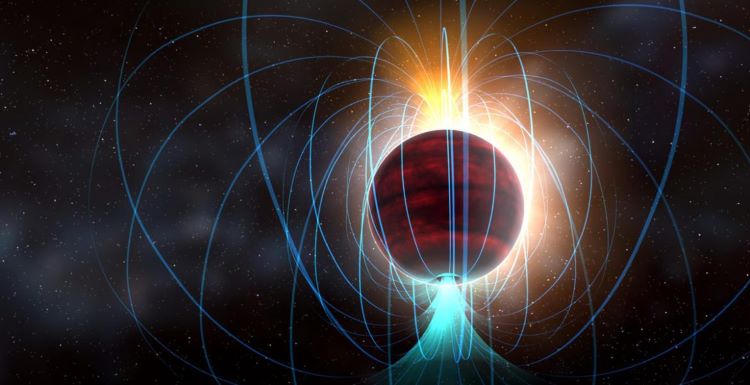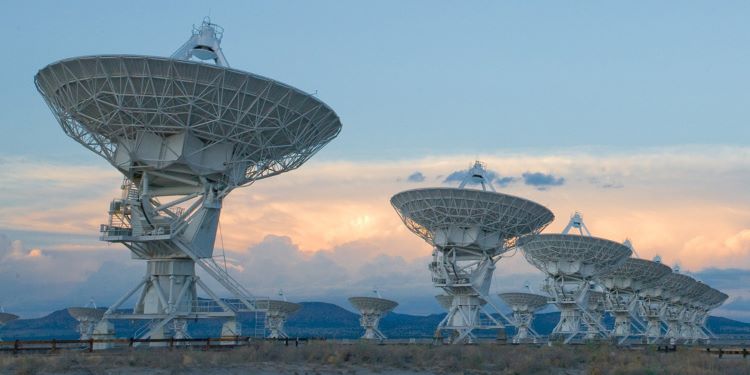Universe Today has investigated the significance of studying impact craters, planetary surfaces, exoplanets, astrobiology, solar physics, comets, planetary atmospheres, planetary geophysics, cosmochemistry, and meteorites, and how these scientific fields contribute to researchers and the public gain greater insight into our place in the universe and finding life beyond Earth. Here, will discuss the field of radio astronomy with Dr. Wael Farah, who is a research scientist at the SETI Institute, about how radio astronomy teaches us about the myriad of celestial objects that populate our universe, along with the benefits and challenges, finding life beyond Earth, and how upcoming students can pursue studying radio astronomy. But what is radio astronomy and why is it so important to study?
“Radio astronomy is a branch of astrophysics dedicated to studying the universe at radio wavelengths, which represent the lowest energy form of the electromagnetic spectrum,” Dr. Farah tells Universe Today. “Originating in the late 1930s, radio astronomy transformed astronomers’ perceptions of the cosmos. Before the serendipitous discovery of radio emissions from the Milky Way, scientists believed that radio emissions from space, attributed to stars and other hot bodies, could only be produced by the “black body” law (or Planck’s law), which accurately predicted that radio emissions should be very weak and undetectable from Earth. However, the discovery of an entirely new emission process, synchrotron radiation, provided an unprecedented lens to view the cosmos through. This opened up a whole new world of discoveries.”
As its name implies, radio astronomy uses radio telescopes to listen to the sounds of the universe, and while radio astronomy is often interpreted as just listening for aliens (which is one branch), most of radio astronomy consists of listening to radio waves from other celestial sources, some of which are millions of light-years from Earth, including gas giant planets, gas clouds, pulsars, the birth and death of stars, galaxy formation and evolution, and the Cosmic Microwave Background Radiation.
The size of radio telescopes range between small, homemade antennas to massive dishes that collect radio waves from space and use computers to boost (also known as “amplify”) the radio signals, followed by using computer programs to translate the signal into easy-to-understand data. Astronomers then use this data to conduct studies on the aforementioned celestial objects, thus increasing our understanding of the universe. But even with all the science being accomplished and the required technology, what are some of the benefits and challenges of study radio astronomy?
“Radio astronomy is an inherently interdisciplinary field, intersecting science, engineering, and computing, which presents both benefits and challenges,” Dr. Farah tells Universe Today. “Speaking of challenges, there’s no shortage of them! Radio Frequency Interference (RFI) poses a significant challenge for radio astronomers. Almost every communication device, from radios and cell phones to satellites and WiFi routers, operates within the radio portion of the electromagnetic spectrum. These devices interfere with radio telescopes and can cause substantial damage to equipment and data. We’re constantly endeavoring to modify our hardware and software to adapt to, or even mitigate, this increasingly detrimental environment.”
Radio astronomy is often described as “observing the invisible universe”, and one example is studying magnetic fields around planets, stars, and even galaxies. This is accomplished through measuring what’s known as synchrotron radiation, which are radio waves created by magnetic fields, and have been identified around black holes, allowing researchers to learn more about the black hole’s behavior and characteristics, including how they digest stars. Within our own solar system, radio astronomy can be used to study the magnetic fields comets, the gas giants, Jupiter and Saturn, and even our Sun. This is because radio telescopes “see” the universe differently than optical telescopes, or visible light. Other examples include quasars, which look like normal stars but can emit powerful radio bursts that radio astronomers collect to learn more about them, including their formation and evolution. But with all these fascinating celestial objects to study, what are some of the most exciting aspects of radio astronomy that Dr. Farah has studied during his career?

“One of my research interests is the study of Fast Radio Bursts (or FRBs in short),” Dr. Farah tells Universe Today. “FRBs are brief but incredibly intense bursts of radio waves, seemingly originating from sources halfway across the universe. Despite their enigmatic nature, our leading theories suggest that FRBs may be linked to highly magnetized neutron stars known as magnetars. FRBs hold the imprint of the medium they travel through, offering a unique window into the universe. I am also interested in the Search for Extraterrestrial Intelligence (or SETI). Radio astronomy is a promising avenue for discovering life beyond our planet, seeking to address one of humanity’s most profound and enduring questions: ‘are we alone in the universe?’.”
Dr. Farah has frequently spoken about the Allen Telescope Array (ATA) in northern California, whose mission is to continue SETI research and provides researchers the opportunity to search the heavens for radio signals from other intelligent civilizations seven days a week. The ATA was heavily-funded by the Paul G. Allen Family Foundation, for which the array is named after, and began operations in 2007.
One of the most famous radio telescopes in the world was the Arecibo Observatory in Puerto Rico, which boasted a massive dish that measured 305-meters (1000-feet) in diameter, and contributed to radio astronomy, radar astronomy, and the Search for extraterrestrial intelligence (SETI) during its service between 1963 and 2020. Unfortunately, Arecibo encountered funding lapses in the early 2000s as NASA put an emphasis on newer radio telescopes, and the disk sustained damage during Hurricane Maria in 2017. In December 2020, support cables that hoisted the instrument platform snapped, causing the platform to crash into the dish. After that, the National Science Foundation (NSF) announced plans to not rebuild the site, but instead have an educational facility put at the location.
The Arecibo Observatory was featured in the film Contact, which Jodie Foster was using to listen for signals from extraterrestrials. While only featured in the beginning of the film, it nonetheless underscored the importance of Arecibo’s role in conducting vital scientific research to help us better understand our place in the universe. The radio observatory that served as the location for Jodie Foster identifying the radio signal from Vega occurred at the Karl G. Jansky Very Large Array (VLA) in Socorro, New Mexico, which is currently operated by the National Radio Astronomy Observatory (NRAO) with funding from the NSF and is actively being used for SETI research. Therefore, what can radio astronomy teach us about finding life beyond Earth?

“Technosignatures, which are indicators of non-anthropogenic technology, serve as one proxy for detecting intelligent extraterrestrial civilizations,” Dr. Farah tells Universe Today. “As an emerging civilization ourselves, humans have utilized radio waves for various purposes like communication services, radar, and sensing. Therefore, it is reasonable to assume that an extraterrestrial civilization would also develop and utilize radio technology, and perhaps even broadcast their existence across the galaxy. Unlike other forms of light that could carry the evidence of life beyond our solar system, radio waves can propagate unobscured by interstellar gas and dust, making them easily detectable across vast distances.”
There are currently more than 100 operational radio telescopes around the world and on all seven continents, with a few space-based radio telescopes, as well. These include the aforementioned VLA but also includes the Five-hundred-meter Aperture Spherical Telescope (FAST) in China, which surpassed Arecibo as the world’s largest filled-aperture radio telescope, which conducts studies on pulsars, interstellar molecules, and SETI research. Given the myriad of science and celestial objects that radio astronomy studies, success requires constant collaboration from scientists across the globe and equally from a myriad of backgrounds, including astronomy, physics, astrophysics, chemistry, computer science, electrical engineering, geology, and geophysics. Therefore, what advice does Dr. Farah offer upcoming students who wish to pursue studying radio astronomy?
“Radio astronomy is deeply rooted in physics, mathematics, and computer science,” Dr. Farah tells Universe Today. “Having a solid understanding of these subjects, as they form the basis of many concepts in radio astronomy, can be extremely helpful when studying the field. I would also encourage upcoming students to try and gain research experience by seeking out opportunities to participate in research projects, internships, or summer projects. Radio observatories often offer positions like telescope operators that can be equally fulfilling and rewarding. Reaching out to potential mentors for projects that one might find intriguing is also very crucial; sometimes a short but concise email that shows passion and interest can go a long way! Radio astronomy is a fascinating field, you can never go wrong!”
As technology continues to help advance our knowledge of the universe, radio astronomy will be at the forefront of gaining that knowledge, and possibly even be responsible for receiving a radio signal from an extraterrestrial civilization from somewhere in the cosmos. This incredible field has allowed thousands of scientists from all over the world to gain new insights about black holes, galaxies, quasars, and even about our Sun and the planets with our solar system. Given the more than 100 active radio telescopes across all seven continents, the future is bright for radio astronomy and the cutting-edge science it can achieve.
“Despite being a relatively young field, radio astronomy has already made significant contributions to astronomy and science, greatly advancing our understanding of the universe,” Dr. Farah tells Universe Today. “This impact has been recognized at the highest levels. The Nobel Prize in Physics was awarded in 1974 for pioneering techniques in radio astrophysics and the discovery of pulsars. In 1978, the Nobel Prize in Physics was awarded for the discovery of the Cosmic Microwave Background and evidence supporting the Big Bang theory. Additionally, in 1993, another Nobel Prize in Physics was awarded for the discovery of binary pulsar systems, which enabled novel methods for studying gravitation. As major discoveries continue to unfold, I anticipate the possibility of another few Nobel Prizes in the coming years. This underscores the scientific richness of the field.”
How will radio astronomy help us better understand our place in the universe in the coming years and decades? Only time will tell, and this is why we science!
As always, keep doing science & keep looking up!

